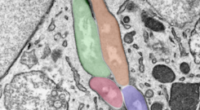Scientists at the Max Planck Institute of Molecular Cell Biology and Genetics (MPI-CBG) in Dresden, Germany, have discovered the importance of the Kynurenine pathway in maintaining retinal health under stress conditions. Their study reveals that the balance between toxic 3-hydroxykynurenine and protective metabolites such as Kynurenic Acid influences the degree of retinal degeneration. By altering the ratio of metabolites of the Kynurenine pathway, retinal health can be improved in certain conditions. The study’s findings have significant implications for treating human diseases related to metabolic pathway imbalances. By identifying the importance of individual metabolites in maintaining retinal health and targeting specific genes within the Kynurenine pathway, new therapeutic strategies for a variety of human diseases could be developed. The accuracy of news releases posted to EurekAlert! by contributing institutions or the use of any information through the EurekAlert system is not the responsibility of AAAS and EurekAlert!.
Eye Color Genes and their Role in Maintaining Retinal Health
Metabolic pathways are a series of biochemical reactions in cells that convert one component into another, and there is mounting evidence that they have a significant impact on the health of cells and tissues, particularly when coupled with external stress factors. The Max Planck Institute of Molecular Cell Biology and Genetics (MPI-CBG) in Dresden, Germany, conducted a study that highlights the essential role of one such metabolic pathway in maintaining retinal health under stress conditions.
The research team, led by Elisabeth Knust, studied the classic Drosophila genes cinnabar, cardinal, white, and scarlet, which were originally named due to their role in eye color pigmentation, specifically the formation of brown pigment in the fly’s eye. These genes encode components of the kynurenine pathway, which converts the amino acid tryptophan by various steps into other products. The study has shed light on the function of this metabolic pathway in retinal health, independent of its role in pigment formation.
The Kynurenine pathway is an evolutionarily conserved metabolic pathway that regulates various biological processes. Disruption of this pathway can lead to the buildup of toxic or protective biomolecules or metabolites, which can adversely or positively impact brain health, including the retina. In their study, the MPI-CBG team used flies as a model system to unravel the role of individual metabolites in maintaining retinal health.
The researchers focused on four genes – cinnabar, cardinal, white, and scarlet – named after abnormal eye colors that occur following their loss in flies. The team investigated whether these genes regulate retinal health independently of their role in pigment formation, considering the remarkable conservation of this metabolic pathway and the genes that regulate it from flies to humans.
Sarita Hebbar, one of the lead authors of the study, stated, “Since the Kynurenine pathway is conserved from flies to humans, we asked whether these genes regulate retinal health independent of their role in pigment formation.”
Many human diseases, including retinal and neurodegenerative diseases, are linked to metabolic pathway imbalances. This study emphasizes the significance of metabolic pathways, particularly the kynurenine pathway, in retinal health and opens up new avenues for exploring its potential implications in human diseases.
In conclusion, the study provides evidence of the vital role of metabolic pathways in maintaining retinal health under stress conditions. The kynurenine pathway, which is evolutionarily conserved and regulates several biological processes, has been shown to play a crucial role in this regard, and the study’s findings could have far-reaching implications in the treatment of human diseases related to metabolic pathway imbalances.
Kynurenine Pathway and Retinal Health
Scientists at the Max Planck Institute of Molecular Cell Biology and Genetics (MPI-CBG) in Dresden, Germany, studied the Kynurenine pathway, which is responsible for the formation of pigments in the eyes of fruit flies. They found that it plays a vital role in maintaining retinal health under stress conditions. The study, which used a combination of genetics, dietary changes, and biochemical analysis of metabolites, focused on four genes – cinnabar, cardinal, white, and scarlet – that encode components of the Kynurenine pathway.
The team discovered that a metabolite called 3-hydroxykynurenine (3OH-K) can damage the retina and that the balance between toxic 3OH-K and protective metabolites, such as Kynurenic Acid (KYNA), influences the degree of degeneration. The researchers also found that by altering the ratio of metabolites of the Kynurenine pathway, retinal health can be improved in certain conditions.
Furthermore, the scientists targeted the four genes to study their influence on retinal health. They discovered that the accumulation of 3OH-K, as well as its location in the cell and its availability in further reactions, is critical to retinal health.
The study highlights the significance of the Kynurenine pathway in maintaining retinal health and presents new avenues for exploring its potential implications in treating human diseases related to metabolic pathway imbalances. The research team believes that in the future, therapeutic strategies for diseases with impaired Kynurenine pathway function, such as those observed in various neurodegenerative conditions, should take into account the ratio of various metabolites and the specific sites of their accumulation and activity.
The findings of this study have significant implications for researchers looking to develop treatments for diseases related to metabolic pathway imbalances. By identifying the importance of individual metabolites in maintaining retinal health and targeting specific genes within the Kynurenine pathway, this study could potentially lead to new therapeutic strategies for a variety of human diseases.
Disclaimer: The accuracy of news releases posted to EurekAlert! by contributing institutions or the use of any information through the EurekAlert system is not the responsibility of AAAS and EurekAlert!.
Don’t miss interesting posts on Famousbio










